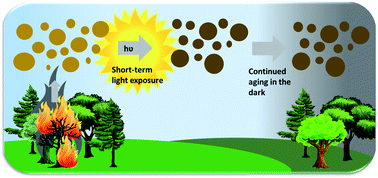Photoreaction of biomass burning brown carbon aerosol particles†
Abstract
The light-absorbing fraction of atmospheric organic particles, known as brown carbon (BrC) aerosol, can affect climate by influencing global radiative forcing. Regional effects arising from biomass burning BrC pollution are of particular interest, as they can have very high optical depth close to their sources. Due to the numerous fuel types, combustion conditions and reaction pathways encountered during the emission and lifetime of BrC, significant uncertainty arises from the impact that atmospheric aging can have on aerosol chemical composition and optical properties. Here, we investigate short-term aging processes driven by exposure to ultraviolet light (≈360 nm) that occur with primary BrC particles generated by smoldering pine wood. Suspended particles were aged in a chamber for a duration of 30 min. The single scattering albedo (SSA) at 405 nm decreased significantly by approximately 0.02 units (for example, from 0.98 to 0.96) during that time, due to an increase in absorption relative to scattering. This change was associated with an increase in oxygenation, represented by the signal fraction at m/z = 44 (f44) from the aerosol mass spectrometer (AMS). Surprisingly, the SSA continued to decrease after light exposure stopped, pointing to the presence of long-lived reactive species, perhaps radicals, that we hypothesize to form from photosensitized reactions. While relative humidity (RH) had only a minor impact on the rate of aging during light exposure, the aging rate in the dark may have occurred faster under dry conditions than at 45% RH.

- This article is part of the themed collection: Best Papers of 2022 from RSC’s Environmental Science journals


 Please wait while we load your content...
Please wait while we load your content...